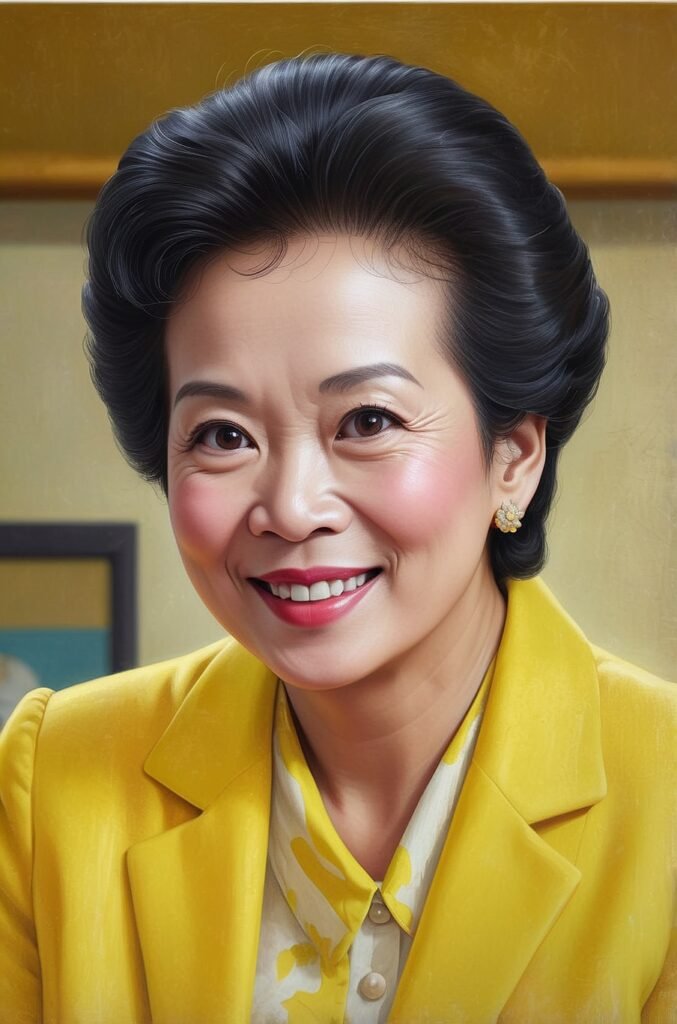Corazon Aquino, affectionately known as “Cory” to millions of Filipinos, holds a significant place in Philippine history as the country’s first female president. Her journey from a self-described housewife to the leader of a nation is a testament to her unwavering commitment to democracy and the power of peaceful resistance. This blog post delves into the life, political career, and lasting legacy of Corazon Aquino, exploring how she became a symbol of hope and change for the Filipino people during a tumultuous period in their history. We will examine her role in restoring democracy to the Philippines after years of dictatorship under Ferdinand Marcos, her challenges as president, and her continued influence on Philippine politics and society long after her term in office.
Early Life and Background
Birth and Family
Maria Corazon Sumulong Cojuangco was born on January 25, 1933, in Paniqui, Tarlac, Philippines. She came from a prominent and wealthy family, with her father, Jose Cojuangco Sr., being a politician and businessman. Corazon was the sixth of eight children, growing up in an environment that exposed her to both political discourse and business acumen from an early age. The Cojuangco family was known for their vast landholdings, including the Hacienda Luisita, one of the largest sugar plantations in the Philippines. This background would later play a significant role in shaping Aquino’s perspectives on land reform and social justice.
Education
Aquino’s education was a blend of local and international experiences, reflecting her family’s status and the prevalent practices among affluent Filipino families of the time. She began her early education in the Philippines, attending St. Scholastica’s College in Manila. In 1946, at the age of 13, she was sent to the United States for further studies. There, she attended the Ravenhill Academy in Philadelphia, the Notre Dame Convent School in New York, and the College of Mount Saint Vincent, also in New York. Aquino’s time in the United States exposed her to Western democratic ideals and practices, which would later influence her political philosophy.
Marriage to Benigno Aquino Jr.
One of the most pivotal moments in Corazon’s personal life was her marriage to Benigno Aquino Jr. in 1954. Benigno, often called “Ninoy,” was a rising star in Philippine politics and would become one of the most vocal critics of Ferdinand Marcos’s regime. The couple’s union was not just a personal partnership but would eventually become a political one as well. Together, they had five children: Maria Elena, Aurora Corazon, Benigno Simeon III (who would later become the 15th President of the Philippines), Victoria Elisa, and Kristina Bernadette. The Aquino family’s life was deeply intertwined with the political landscape of the Philippines, setting the stage for Corazon’s future role in the country’s history.
The Marcos Era and Political Awakening
Rise of Ferdinand Marcos
Ferdinand Marcos was elected President of the Philippines in 1965, initially bringing hope for progress and development. However, his presidency soon took an authoritarian turn. In 1972, citing the threat of communist insurgency, Marcos declared martial law, effectively consolidating his power and silencing opposition. This period marked the beginning of what many Filipinos refer to as the “Marcos dictatorship,” characterized by human rights abuses, corruption, and economic decline.
Benigno Aquino Jr.’s Opposition
Benigno Aquino Jr., Corazon’s husband, emerged as one of the most prominent critics of the Marcos regime. His outspoken opposition led to his arrest and imprisonment in 1972, shortly after the declaration of martial law. Aquino spent seven years in prison, including a period of solitary confinement. During this time, Corazon Aquino became her husband’s link to the outside world, delivering his messages and maintaining his political connections. This experience marked the beginning of her own political involvement, albeit in a supporting role.
Exile and Assassination
In 1980, Marcos allowed Benigno Aquino Jr. to leave for the United States for medical treatment. The Aquino family lived in exile in Massachusetts for three years. During this time, Corazon Aquino experienced life away from the intense political atmosphere of the Philippines, but remained connected to the ongoing struggle for democracy in her home country. In 1983, despite warnings about the risks to his life, Benigno Aquino Jr. decided to return to the Philippines to challenge Marcos’s rule. Tragically, he was assassinated on August 21, 1983, moments after stepping off the plane at Manila International Airport (now named Ninoy Aquino International Airport in his honor).
Corazon Aquino’s Transformation
The assassination of Benigno Aquino Jr. was a turning point not only for the Philippines but also for Corazon Aquino personally. The event galvanized the opposition movement against Marcos and thrust Corazon into the spotlight. Initially reluctant to take on a political role, she found herself becoming a symbol of the struggle against the Marcos regime. Her transformation from a supportive wife to a political leader in her own right began in earnest, as she became increasingly involved in the opposition movement and began to speak out against the injustices of the Marcos government.
The People Power Revolution
Snap Election of 1986
In November 1985, in response to mounting pressure both domestically and internationally, Ferdinand Marcos called for a snap presidential election to be held in February 1986. The opposition, seeing an opportunity to challenge Marcos’s rule, united behind Corazon Aquino as their candidate. Despite her initial reluctance, Aquino agreed to run, driven by a sense of duty to continue her husband’s fight for democracy. The campaign was intense and marked by allegations of fraud and intimidation by the Marcos regime.
Election Results and Controversy
The election was held on February 7, 1986, and was marred by widespread reports of electoral fraud and violence. The official count by the Commission on Elections (COMELEC) declared Marcos the winner, while the independent National Movement for Free Elections (NAMFREL) showed Aquino leading. This discrepancy led to accusations of massive cheating by the Marcos camp, further fueling public outrage and discontent.
The EDSA Revolution
The disputed election results sparked what would become known as the People Power Revolution or the EDSA Revolution (named after Epifanio de los Santos Avenue, where many of the demonstrations took place). From February 22 to 25, 1986, millions of Filipinos took to the streets in a largely peaceful protest against the Marcos regime. The revolution was characterized by its non-violent nature, with protesters offering flowers to soldiers and nuns praying in front of tanks.
Key Events of the People Power Revolution:
| Date | Event |
|---|---|
| February 22, 1986 | Defense Minister Juan Ponce Enrile and Vice Chief of Staff Fidel Ramos announce their defection from Marcos |
| February 23, 1986 | Cardinal Jaime Sin calls on Filipinos to support the rebels |
| February 24, 1986 | Massive crowds gather on EDSA to protect the rebel camps |
| February 25, 1986 | Marcos flees the presidential palace; Corazon Aquino is sworn in as President |
Aquino’s Role in the Revolution
Throughout the revolution, Corazon Aquino played a crucial role in mobilizing and inspiring the Filipino people. Her calm demeanor and unwavering commitment to non-violent protest were instrumental in maintaining the peaceful nature of the revolution. Aquino’s leadership during this critical period demonstrated her ability to unite diverse groups of people around a common cause, a skill that would prove invaluable in her subsequent role as president.
Presidency (1986-1992)
Taking Office
Corazon Aquino was sworn in as the 11th President of the Philippines on February 25, 1986, marking the end of the Marcos era and the beginning of a new chapter in Philippine democracy. Her inauguration was a powerful symbol of change, representing not only the first female president of the country but also the restoration of democratic rule after years of dictatorship.
Key Challenges
Aquino’s presidency faced numerous challenges from the outset. She inherited a country with a struggling economy, significant foreign debt, and deep-rooted corruption. Additionally, she had to navigate the complex task of dismantling the structures of the Marcos regime while building new democratic institutions.
Major Initiatives and Accomplishments:
- Constitutional Reform: One of Aquino’s most significant achievements was the drafting and ratification of the 1987 Constitution. This new constitution restored the presidential system of government, strengthened checks and balances, and included provisions to prevent future dictatorships.
- Economic Reforms: Aquino implemented economic liberalization policies, including privatization of government-owned corporations and the promotion of foreign investment. These reforms aimed to stabilize the economy and promote growth.
- Land Reform: The Comprehensive Agrarian Reform Program (CARP) was launched to redistribute land to small farmers and landless rural workers. However, the implementation of this program faced significant challenges and criticism.
- Human Rights: Aquino established the Presidential Committee on Human Rights to investigate abuses committed during the Marcos era and worked towards the release of political prisoners.
- Foreign Policy: She pursued a more independent foreign policy, including the closure of U.S. military bases in the Philippines, which had been a contentious issue for many years.
Challenges and Criticisms
Despite her achievements, Aquino’s presidency was not without its critics. Some of the key challenges and criticisms included:
- Multiple coup attempts by disgruntled military factions
- Slow pace of economic recovery and persistent poverty
- Criticism of her leadership style as indecisive
- Challenges in implementing comprehensive land reform, particularly regarding her family’s estate, Hacienda Luisita
- Ongoing insurgencies from communist and separatist groups
Legacy of the Aquino Presidency
While opinions on Aquino’s presidency remain divided, her role in restoring democracy to the Philippines is widely recognized. Her term laid the groundwork for democratic institutions and processes that continue to shape Philippine politics today. The peaceful transition of power at the end of her term in 1992 was itself a significant achievement, demonstrating the stability of the democratic system she helped establish.
Post-Presidency and Continued Influence
Continued Political Involvement
After leaving office in 1992, Corazon Aquino remained an influential figure in Philippine politics and civil society. She continued to speak out on important issues and was often seen as a moral compass for the nation. Aquino was particularly vocal during times of political crisis, such as during attempts to amend the constitution or allegations of corruption in subsequent administrations.
Advocacy and Social Work
In her post-presidency years, Aquino focused on various advocacy efforts and social causes. She was involved in several non-governmental organizations and foundations, including:
- The Benigno S. Aquino Foundation: Focused on continuing her late husband’s legacy and promoting democratic values
- Gawad Kalinga: A poverty alleviation and nation-building movement
- Pinoy ME Foundation: A microfinance initiative aimed at helping small entrepreneurs
Role in Later Political Movements
Aquino played a significant role in later political movements, particularly during times of perceived threats to democracy. Notable instances include:
- EDSA II (2001): Aquino supported the movement that led to the ouster of President Joseph Estrada amid corruption allegations.
- Opposition to Charter Change: She consistently opposed attempts to amend the 1987 Constitution, viewing such efforts as potential threats to democracy.
- Criticism of the Arroyo Administration: Aquino became increasingly critical of President Gloria Macapagal-Arroyo’s administration, particularly regarding allegations of electoral fraud and corruption.
International Recognition
Aquino’s contributions to democracy and human rights continued to be recognized internationally long after her presidency. She received numerous awards and honors, including:
- Ramon Magsaysay Award for International Understanding (1998)
- U.N. Prize in the Field of Human Rights (1998)
- Time Magazine’s “Asian Heroes” (2006)
Personal Life and Final Years
Family and Personal Interests
Despite her public role, Aquino remained devoted to her family throughout her life. She was particularly close to her children and grandchildren, often speaking about the importance of family values. In her private time, Aquino enjoyed painting and would sometimes auction her artwork for charitable causes.
Health Struggles and Passing
In March 2008, Aquino was diagnosed with colon cancer. She underwent chemotherapy and other treatments, but her condition continued to deteriorate. Throughout her illness, she received an outpouring of support from the Filipino people, demonstrating the enduring affection many held for her.
Corazon Aquino passed away on August 1, 2009, at the age of 76. Her death was mourned nationwide, with thousands of Filipinos lining the streets for her funeral procession. The event was reminiscent of the People Power Revolution, with many wearing yellow – the color associated with Aquino and the democracy movement she led.
Legacy and Impact on Philippine Society
Political Legacy
Corazon Aquino’s most enduring legacy is her role in restoring democracy to the Philippines. The institutions and processes she helped establish continue to form the backbone of Philippine democracy. Her presidency set precedents for peaceful transitions of power and civilian control over the military.
Inspiration for Women in Politics
As the first female president of the Philippines, Aquino paved the way for greater participation of women in Philippine politics. Her presidency challenged traditional gender roles and demonstrated that women could effectively lead at the highest levels of government.
Symbol of Democracy
Beyond her specific policies and actions, Aquino became a powerful symbol of democracy and peaceful resistance. Her transformation from a housewife to a national leader inspired many Filipinos and people around the world, demonstrating the power of ordinary citizens to effect change.
Continuing Influence
The “Cory Magic,” as it was often called, continued to influence Philippine politics long after her presidency. This was evident in the election of her son, Benigno Aquino III, as president in 2010, largely on a platform that invoked his parents’ legacy.
Impact on Philippine Democracy
To illustrate the long-term impact of Aquino’s presidency on Philippine democracy, consider the following data on voter turnout in presidential elections before and after her term:
| Year | Voter Turnout (%) | Notes |
|---|---|---|
| 1981 | 80.0 | Last election under Marcos (boycotted by opposition) |
| 1986 | 95.0 | Snap election that led to People Power Revolution |
| 1992 | 78.1 | First post-Aquino election |
| 1998 | 78.7 | |
| 2004 | 84.1 | |
| 2010 | 74.3 | Election of Benigno Aquino III |
| 2016 | 81.9 |
This data shows consistently high voter participation in the post-Marcos era, reflecting the enduring engagement of the Filipino people in the democratic process that Aquino helped restore.
Conclusion
Corazon Aquino’s journey from a supportive political wife to the leader of a nation encapsulates a crucial period in Philippine history. Her presidency, while not without its challenges and criticisms, marked a turning point in the country’s path towards democracy. Aquino’s legacy extends beyond her specific policies or achievements in office; she became a symbol of democratic values and peaceful resistance against tyranny. Her influence on Philippine politics and society continues to be felt today, inspiring new generations of leaders and citizens to uphold the principles of democracy and good governance. As the Philippines continues to navigate the complexities of modern governance, the example set by Corazon Aquino remains a touchstone for those seeking to build a more just and democratic society.
Disclaimer: This blog post aims to provide an accurate and comprehensive overview of Corazon Aquino’s life and legacy based on widely available historical information. However, interpretations of historical events and their impacts can vary. We encourage readers to consult multiple sources for a broader understanding. If you notice any inaccuracies in this post, please report them so we can promptly make corrections.




